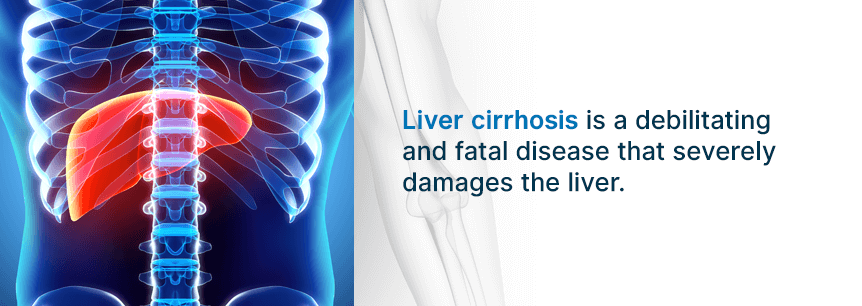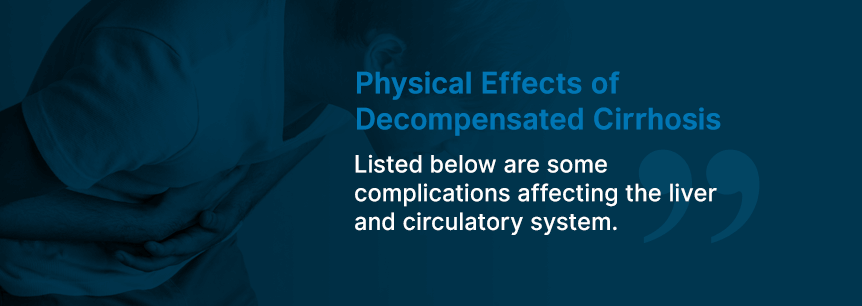
Every year in America, approximately 31,000 people die from cirrhosis, according to Johns Hopkins Medicine. Many of these cases are due to chronic hepatitis C or liver disease from alcoholism. For the most part, cirrhosis of the liver is not curable. However, some patients receive a liver transplant.
For the majority of patients suffering from cirrhosis, life is full of pain, fatigue, and depression. Conventional medicine doesn’t always help, due to some harmful side effects associated with it.
The benefits of medical marijuana keep growing for many people suffering from chronic diseases. The good news is, medical marijuana and decompensated cirrhosis can help reduce many of these unwanted side effects and symptoms.
The two stages of liver cirrhosis are compensated and decompensated.
The last stages of liver cirrhosis usually take some years to present. Unfortunately, decompensated cirrhosis eventually happens, and it can be fatal. However, acute liver failure can occur at any stage of the disease.
If your doctor diagnoses cirrhosis in its early stages, they can treat it, and potentially prevent additional damage.
The liver is a vital organ that removes harmful substances from the body through a detoxifying process. It cleanses the blood and produces crucial nutrients necessary for the body to function.
Liver cirrhosis is a debilitating and fatal disease that severely damages the liver. There can be many reasons one gets liver disease, but the main reasons are hepatitis and chronic alcoholism.

Although the liver tries hard to repair itself, too much injury can cause irreversible damage. Each time the liver tries to recover itself, scar tissue forms. The more scar tissue, the more difficult it is for the liver to function properly. The further cirrhosis progresses, the less likely the liver can repair itself from damage.
The following is a list of the different diseases or causes potentially leading to cirrhosis of the liver.
Other possible causes include:
The following symptoms can occur when the disease progresses from compensated to decompensated.
Due to the liver breaking down and severe damage occurring, there can be many more symptoms involved.
Listed below are some complications affecting the liver and circulatory system.

Other complications include the following.
Due to the ongoing complications and multiple symptoms, it’s no wonder some patients suffer from mental disorders such as anxiety and depression. But various MRI studies have shown these symptoms, including a change in the default-mode network in previous resting-state studies.
According to the National Institutes of Health, facts about cirrhosis include:
In 2013, the number of deaths from cirrhosis rose to nearly 38,000, making it the 12th most common cause of death in the U.S.
Changes in assumptions about alcohol use and its major cause of liver cirrhosis have occurred since the turn of the century. Social and political views have determined the temperance movement, which has had a profound effect on medical and public health discussions and implementations of the role of alcohol use in liver disease.
During the 19th century, many clinical and epidemiological approaches emphasized the importance and the direct correlation between liver cirrhosis and alcoholism. However, during the turn of the century and the temperance movements, ideas changed about alcohol.
Both of these eras saw changes in alcoholism and liver cirrhosis based on the liberalization and changes in drinking norms in American society. Due to these changes, cirrhosis and the correlation between it and alcoholism became minimized. People blamed the disease on industrial toxins and air pollution. However, in recent years, research has shown heavy drinking and alcoholism is a direct cause of liver cirrhosis.
As with any disease, your physician will assist with any medical treatment, which includes:
To prevent excess water weight or fluid buildup, a low-sodium diet will prevent, or at least reduce, ascites and edema. Medications can control severe fluid buildup, and certain procedures can drain the fluid and relieve tension and pressure. Doctors can insert a small tube — known as a transjugular intrahepatic portosystemic shunt, or TIPS — into a vein in the liver to reduce blood pressure in the liver and release fluid buildup.
One way to treat the increased blood pressure in the veins is with blood pressure medication your doctor can prescribe, which will also prevent severe bleeding. Your doctor can also perform an upper endoscopy to check for enlarged veins in the esophagus and stomach possibly causing bleeding.
If you’re having a moderate case of bleeding and develop varices, your doctor can prescribe medication to reduce the bleeding. Some patients who can’t handle the medication for whatever reason may consider having a band ligation procedure to stop or reduce the bleeding. In severe cases, your doctor may decide to insert a TIPS in the vein of your liver to reduce blood pressure and prevent further bleeding.
To reduce the likelihood of infections, your doctor can prescribe antibiotics and may recommend you getting certain vaccinations for hepatitis, pneumonia and the flu.
To reduce the chances of liver cancer, your doctor will suggest a regular checkup, blood tests, and ultrasounds every six months.
To avoid the buildup of toxins in your blood, your doctor may prescribe certain medications to address this brain disorder issue effectively.
Often, medical professionals suggest a liver transplant with advanced cases of liver cirrhosis or when the liver stops functioning. Some signs that show advanced cases of cirrhosis of the liver are:
Cirrhosis of the liver is the most common reason for a liver transplant. Most liver transplants are from a deceased donor. In rare cases, part of a liver will come from a living donor.
Advanced strategies for treating decompensated cirrhosis aim at preventing multiorgan failure and complications to prolong a patient’s survival and improve their quality of life.
Additionally, there are two present clinical trials.

Research has shown some improvement in treating cirrhosis with cannabis. The impact of medical cannabis for decompensated cirrhosis is complicated, but cannabinoids from cannabis had some positive impact on the body’s endocannabinoid system, which directly affects cirrhosis, fibrosis and other liver diseases.
There have been some beneficial effects of CB2 receptor activation on an alcoholic fatty liver, fibrosis, injury to the liver, hepatic inflammation, and regeneration. Studies have shown using the CB2 receptor found in cannabis may provide therapeutic relief for patients suffering from cirrhosis of the liver and other liver diseases.
One independent study showed some alcohol users who used cannabis had a lower risk of developing the following conditions:
Some symptoms cannabis and decompensated cirrhosis help treat include:
Pain relief is one major benefit of using cannabis for those suffering from cirrhosis of the liver. More states are allowing patients with cirrhosis of the liver to seek pain treatment with medical marijuana and hopefully enjoy less pain and a better life. It is a safer option since addiction to prescription opioids is on the rise.
Medical marijuana, including cannabinoids and THC, have shown to be more effective at treating nausea than many medications.
Research has revealed medical marijuana is effective when it comes to improving sleep and helping one stay asleep. It also doesn’t have the side effects other medications have when treating insomnia.
Early research studies show medical marijuana can effectively treat anxiety. It has some of the same ingredients over-the-counter medications contain.
One of the most popular anxiety medications is benzodiazepines. It has a neurotransmitter called GABA working to balance anxiety levels quickly. The problem with this medication is that it is very addictive. Patients quickly build up a tolerance to it, and it causes thousands of overdose deaths every year.
Medical marijuana can also manage the levels of GABA in your brain, according to early research studies, due to the cannabidiol it contains.
Recent surveys conducted at the University of Southern California show interesting results regarding marijuana and depression with those who use marijuana and those who do not. Out of the 4,400 surveyed, those who used marijuana had fewer signs of depression than those who do not use marijuana.
Here is a list of good marijuana for decompensated cirrhosis strains to use.
You can ingest cannabis in several ways to help you benefit from the drug. The methods you can use marijuana and decompensated cirrhosis treatment include:
Finding the best method for you can take trial and error and work with your physician and budtender. Smoking weed, however, may not be the optimal method, as it can impact respiratory function in the same way tobacco can.

If you’re suffering from cirrhosis and its many symptoms and are ready to begin looking into how cannabis for decompensated cirrhosis may help make your quality of life better, feel free to start your search here at MarijuanaDoctors.com.
Be sure to write down the questions you want to discuss with the doctor during your online consultation. You can also search for a medical marijuana doctor to provide you with the recommendation you need for medical cannabis. Once you have your medical marijuana product in hand, you can locate a cannabis dispensary to purchase your products.
Find A Doctor Find A Dispensary